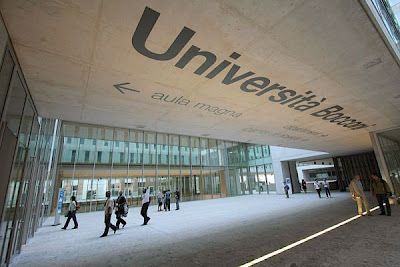As I sit by the study tables on the third floor of the Sraffa building, with my 30 cent cappuccino cioccolato in hand, the concept of being in Italy slowly seeps into my mind. Attending a private school, and more importantly Bocconi University, is very different from anything I have ever experienced, especially at UCSB. The beach has been replaced by a bustling, busy city and the surfers have been replaced by wealthy Italian students. Don’t expect to walk into class with your basketball shorts and sleeveless tank, students here dress to impress and by that I mean fur coats, designer clothing, Prada and Louis Vuitton bags to hold their scholastic belongings. Bocconi prides itself in preparing students for professionalism and success, and this involves outward appearances.
 |
| The inside of the Sraffa Plaza |
When deciding to journey towards Milano, my main incentive was to attend a school which upholds a high reputation for training in economics and business. I’ve definitely diversified my course selection by taking a finance course, and then experimenting with various Economic electives. My schedule consists of Introduction to Consulting Management, I am currently walking the tightrope between being extremely impressed and slightly disappointed when it comes to the scholastic environment at Bocconi. I will attempt to explain:
Pros:
1. From the first day of lecture, professors were bringing real life situations into the classroom. The majority of the teachings began as theory based, and were then turned into practical application by discussing what was going on in the world around us. For example in my Social Responsibility course we were discussing the work ethic behind Ryan Air, how they can afford to offer such cheap flights and the toll this takes on the stakeholders of the company. Another example can be seen in my Sustainability course, dealing with sustainable management tactics, we are delving into the problems behind the dismantling and disposing of oil rigs. Its actually quite depressing, many of these installations have lifetime operations that are nearing an end, yet there has been an immense lack of innovation in regards to disposal at the end of their useful life.
2. Classes are smaller so there is an increased amount of student participation (this could either be seen as a pro or con, depending on your stance with regards to classroom involvement).
3. With the combination of café vending machines located around the end of every corner, and heavy chain smoking, professors realize the short attention span students truly have. Therefore, breaks are usually given for a few short minutes in between classes, these pauses are the perfect time to run over to the vending machine and grab yourself a quick cappuccino.
4. Internet in classrooms!!! A pro that only further fuels my last point.
Cons:
1. As stated previously in pro #3, another side of the argument consists of the fact that classes last approximately an hour and a half. In comparison to the fifty minute courses I’ve experienced throughout my time at UCSB, once you past that first hour, it only goes downhill from there…
2. In regards to my accommodation, living at Arcobolena is extremely far from campus. Definitely out of walking distance, but about 25 minutes on the tram. This is not usually a problem, but when you have class at 8:45 am and everyone is trying to get to work, the seemingly 25 minute tram ride can easily turn long. Then again, it could be seen as my fault for signing up for a class any time earlier than 10.
3. There is a strong emphasis based on passing rather than excelling. It’s hard to make a thorough evaluation of why this is the case, but I’m assuming it is either because the exams are so difficult that they are encouraging us to study or because they know a majority of us are exchange students, and that the extent of our readings are done while on a plane to our next destination within Europe. I would probably go with the latter, but I will definitely keep you all updated with the conclusion.
